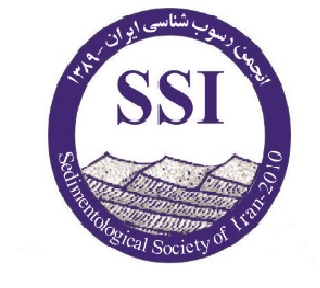The role of tectonic structures in conducting groundwater inflow to the second part of Zagros water tunnel – Kermanshah province
Subject Areas :HamidReza Nasseri 1 , Narges Bayat 2 , Lili Izadi Kian 3 , Farshad Alijani 4
1 -
2 -
3 -
4 -
Keywords: Groundwater flow Geological structure Zagros water tunnel Kermanshah,
Abstract :
High local groundwater flow into rock tunnels is a technical and environmental problem for underground constructions. Geological structures such as faults, open fractures, and dissolution channels could play important roles in conducting ground waters to the tunnels. However, prediction of groundwater inflow from these structures using analytical and empirical method often failed due to given hydrogeological assumptions and simplification such as a homogeneous and isotropic porous medium around the tunnel. The Zagros water tunnel is located in the northwest of Kermanshah province. A huge amount of groundwater flow into the tunnel through fractures occurred during drilling of the second part of tunnel. The second part of tunnel passes through Pabdeh and Gurpi formations. A considerable amount of groundwater flushed into the tunnel when the Ilam Formation was penetrated, causing numerous problems and great damage to the drilling operation. The goal of this study is to identify the factors that influenced water flows into the tunnel. To this purpose, geological features of high flow rate zones have been identified and investigated. The highest input rate (800 l/s) was recorded in the zone Hz23 located in Kurdighaseman anticline. The relationship between geological features and the groundwater inflow into the tunnel indicated that faults play conveying role for ground water into the tunnel. Evaluation of high local groundwater inflow to rock tunnels based on characterization of geological structures is more reliable compared to available analytical and empirical estimation.
1. تصاویر ماهوارهای Map Bing.
رفيعي، ر.، رمضان زاده، ا.، سرشکي، ف. و موحدي نژاد، ا.، 1392. بررسي تاثير خصوصيات درزه¬ها بر روي جريان پايدار آب ورودي به تونل مطالعه موردي: تونل سوم کوهرنگ. نشریه مهندسی تونل و فضاهای زیرزمینی. دوره دو، شماره دو.
شرکت ملی نفت ایران، 1388. نقشه زمینشناسی باینگان با مقیاس 1:100000.
شرکت ملی نفت ایران، 1388. نقشه زمینشناسی قصر شیرین با مقیاس1:100000.
مهندسین مشاور ایمن سازان، 1385. گزارش زمین¬شناسی تکمیلی، هیدروکلیماتولوژی، هیدروژئولوژی، آماربرداری ادواری گمانه¬ها و منابع آب زیرزمینی مسیر تونل انتقال آب زاگرس.
مهندسين مشاور لار، 1388. گزارش مطالعات هیدروژئولوژی مسير قطعه دوم تونل زاگرس.
Berkowitz, B., 2002. Characterizing flow and transport in fractured geological media: A Review. Advances in Water Resources, 25,861-884.
Butron, C., 2012. Drip sealing of tunnels in crystalline rock: Pre-Excavation design and evaluation. Doctoral thesis, Department of Civil and Environmental Engineering, Chalmers University of Technology, GÖteborg. 90.
Fransson, A. and Hernqvist, L., 2010. Geology, water inflow and grout selection for tunnel sealing: case studies from two tunnels in hard rock, Sweden. In: Proceedings of the ITA-AITES World Tunnel Congress, Vancouver.
Goel, R.K., 2014. Tunnelling through weak and fragile rocks of Himalayas. International Journal of Mining Science and Technology, 24, 783–790.
Hernqvist, L., Butron, Ch., Fransson, Å., Gustafson, G. and Funehag, J., 2012. A hard rock tunnel case study: Characterization of the water-bearing fracture system for tunnel grouting, Tunnelling and Underground Space Technology, Vol 30, pp 132–144.
Iwai, K., 1976. Fundamental studies of fluid flow through a single fracture. Ph.D. Thesis, UC, Berkeley.
Lin, H. I. and Lee, C.-H., 2009. An approach to assessing the hydraulic conductivity disturbance in fractured rocks around the Syueshan tunnel, Taiwan. Tunneling and Underground Space Technology, 24, 222–230.
Milanovic, P., 2007. Nowsoud Water Conveyance Tunnel Project. Mission Report, Iran Water and Power Resources Development Company.
Palmstrom, A. and Stille, H., 2007. Ground behavior and rock engineering tools for underground excavations. Journal of Tunneling and Underground Space Technology, 22, 363–376.
Riedmuller, G., 1987. Neo formation and transformation of clay minerals in tectonic shear zones. Tschermaks mineralogische und petrographische Mitteilungen, 25, 219 – 242.
Shahriar, K., Sharifzadeh, M. and Khademi, H.J., 2008. Geotechnical risk assessment based approach for rock TBM selection in difficult ground conditions. International journal of Tunneling and Underground Space Technology, 23, 318–325.
Snow, D.T., 1965. A Parallel plate model of fractured permeable media. Ph.D Thesis, UC, Berkeley.
Wenner, H. and Wannenmacher, D., 2009. Alborz service tunnel in Iran: TBM tunneling in difficult ground conditions and its solutions. In: Proceedings, 8th Iranian Tunneling Conference, 342–353.
Zarei, H.R., Uromeihy, A. and Sharifzadeh, M., 2011. Evaluation of high local groundwater inflow to a rock tunnel by characterization of geological features. Journal of Tunneling and Underground Space Technology, 26, 364–373.

